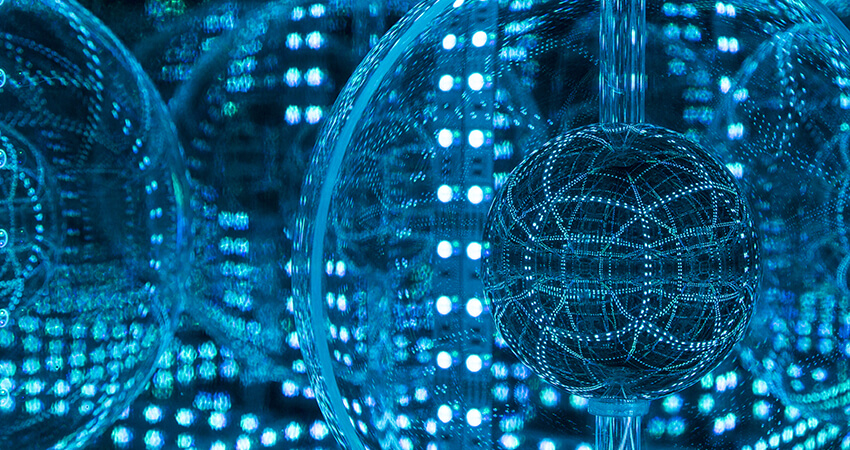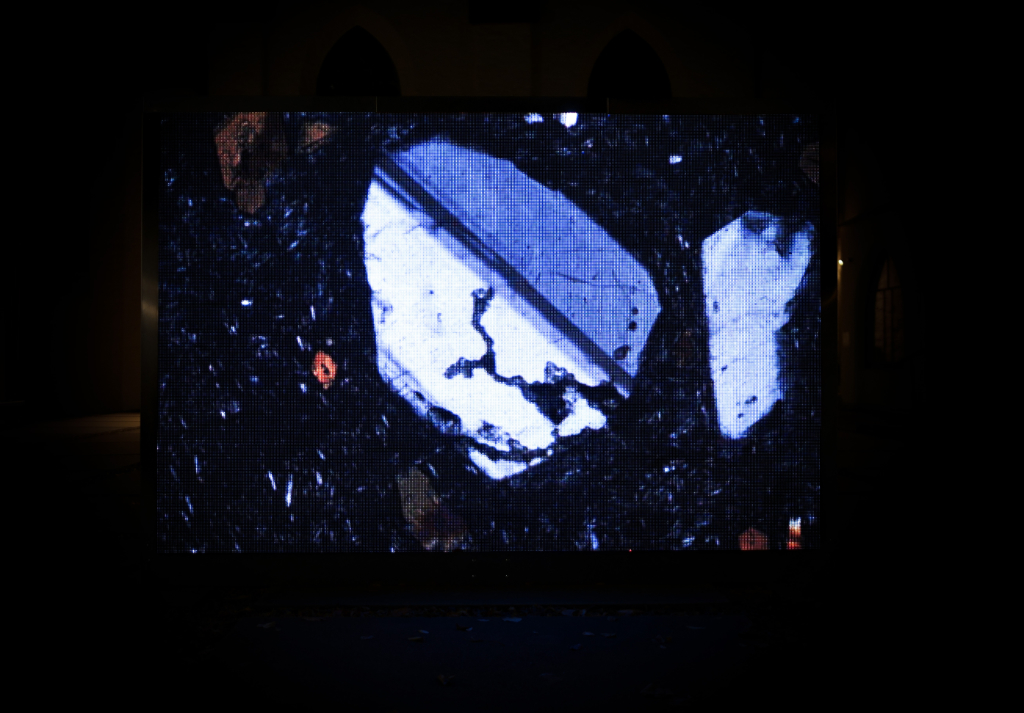Text by Živa Brglez

In the current art realm, technology (frequently coupled with science) is often employed for its spectacular properties, fashionable aspects or general edginess. The bet seems to be that if the form is comprised of the latest, top-notch technology (one that maybe hasn’t even fully emerged yet), then maybe the corresponding art piece/practice could be regarded as highly innovative accordingly, hence also very valuable within the art world.
In other words, if the medium or form itself is new, if it once more transgresses conventional definitions or views of art, the bet is that this could (or should) count for something by itself. London-based multimedia artist Aphra Shemza doesn’t want to play this game. Although “technology” is definitely one of the keywords with which one should describe her practice, her choice of artistic medium is principally traditional.
Mostly, she creates using sculpting techniques while combining them with the procedures that contemporary technology has to offer. But, the result is usually still a sculpture, that is, a traditional medium. Sometimes it is a proper installation, and other times it seems that the object, albeit 3D, feels completely at ease with losing one dimension and immersing itself in two-dimensional qualities, for example, the Compositions 1-4. Within her artistic practice, she often tries to balance the organic or natural with the technology and the traditional with not-yet-conventional.
Very illustrating this aspect is her series Totem. The choice of medium is, again, fully traditional – sculpture – and so is, probably, for the most part, her technique. But, the strict geometry, colouring and light remind us that this wooden monumental object is a manifestation not only of something already here but also of something timeless… but – at the same time – something yet to emerge – a kind of “hybrid nature”.
Much of her work has the appearance qualities of highly aesthetically polished objects. For some, these are reminiscences of Modernism. A good example would be Polygon I – but, as one could argue, only at first sight. Indeed, the story once again unfolds conceptually between balancing the man-made with the natural. Furthermore, with its translucent properties, the piece also considers luminescence and the viewer. The two further key interests of Aphra Shemza’s work can be clearly traced in her Composition μX, which represents a kind of universe modelled on Kepler’s Platonic Universe, lit with LED lights that can be manipulated by the viewer.
In 2016, Aphra Shemza co-founded the FLUX organization, devoted to cultivating the media arts community in the UK. Two years later, she created ARTOLOGY, a platform that promotes sustainability within art practice. It focuses on what artists working with technology should consider before creating the work. For example, what kind of environmental impact will their work have and how to ensure the work’s longevity? In Aphra Shemza’s work, this is revealed in pieces like the above-mentioned Compositions 1-4, which are made of recycled or reused materials, and in pieces like Current Climate. The latter is not ecological only via its conceptual and material baselines but also concerning its clearly observable content. It is a “real-time data visualization” of the climate change discourse of four countries chosen for their contribution to the issue (or the lack thereof). Below, four wooden tree trunks brightly shine four differently coloured lights, which change whenever the country news outlets mention climate change.
Aphra Shemza’s work is thus hard to characterize unambiguously. Sometimes it leans towards design. Other times take is nearly political. Another time it becomes very elusive for its transient, seemingly eternal qualities. One common line or denominator does make itself apparent, though. It is her consistent sustainability awareness, embodied in various forms, objects and ideas, which she tries to encourage through her artistic practice and several online and offline platforms, talks and workshops.


Right: Totems I.VI-I.VIII, Aphra Shemza (2017). Photo: David Wilman
What is the intellectual process behind ‘Solutions for a Sustainable Art Practice’?
I like to think of art as a tool with which artists can explore and raise questions about our human existence, the lives we lead and the society we inhabit. I feel that being an artist working with technology puts me right at the forefront of this discourse. I invite innovation and look towards the future but am forced into a dialogue with our throw-away consumer culture as part of my process.
While excited about what these new media allow me to explore, I am apprehensive about the unknowns they present in terms of material stability, sustainability and maintenance. Solutions for a Sustainable Art Practice was created in response to the Art Council’s Developing Your Creative Practice Grant. My bespoke artist development program ran for three months, allowing me the opportunity to pursue a focused investigation into finding practical, sustainable alternatives to the materials I use to make my work.
I have also published all my research and concepts on a peer-led platform called ARTOLOGY for other artists who wish to pursue a more mindful creative process and curated and hosted a FLUX talks event called Radical Ecology: Sustainable Media Art in collaboration with Julie’s Bicycle, Bowarts, Arts Admin and Ugly Duck presenting three artist speakers concerned with these concepts.
Could you expand more on what a sustainable art practice is for you?
I look at sustainability in two different ways. The first one can sustain practising as an artist for many years to come. Here the artist would be looking at ways they can survive and produce work or a way of working that would enable them to continue their practice in the future. Secondly, sustainable art practice in the more ecological sense would involve being considerate and mindful of the materials you use to create your work at the point of idea creation and using reclaimed or recycled materials, sourcing local, and using fair trade electronics and materials that are not harmful to the environment. Also, being responsible at the point of sale that the buyer knows how to look after your work correctly to avoid it being thrown away at a later date, the lifespan of the work is a key concern.
There is a long way for me to go in my practice to become fully sustainable. I have only just begun my journey into this field and, through doing so, have found that there is still so much more to learn. Still, the community of people I have met so far are open and bursting with life and knowledge that they want to share, so here’s hoping I can start making changes that could create a ripple that could gather momentum across the creative industries.
You are one of the founders of FLUX Events; could you tell us more about FLUX and the events you run?
FLUX was founded in 2016 at Lights of Soho Gallery in London by the artists Maria Almena, Oliver Gingrich and me. FLUX is a charitable organisation committed to furthering the development of the media arts community in the UK. As an artist-led forum, FLUX offers a space for collaboration and exchange as key artists and organisations come together to profile their work. FLUX brings these ideas to the wider public through talks events, performance evenings, workshops and exhibitions, providing a fluid platform to discuss strategies, processes and collective themes within the media arts.
2018 was our best year yet. We grew into a thriving network of over 2000+, with an active artist population engaging in regular meet-ups for talks, conferences, presentations, and exhibitions. In June, we hosted our first large-scale exhibition: ART IN FLUX featuring 14 interactive installations, 30 speakers, 6 performances and a workshop. In July, we produced our first fully funded community outreach project called AYAH-Sign, a project on Digital Islamic Art in collaboration with the artist Sara Choudhrey, the Grenfell community, Arts Council England & Royal Borough of Kensington and Chelsea. In addition, we’ve been busily organising our talks program of 10 evenings throughout the year hosted at the Library Club, covering themes such as; the Post-Human, Embodiment of Technology and New Social Sculpture.
What expectations did you have, and what did you achieve?
FLUX exists to support and inspire new media artists in the UK, we wanted to create a platform for artists to come together and learn, inspire and collaborate with one another, and I think we have done just that.
This year we have a complete program of monthly social events in our intimate setting at the Library London. The audience gets the opportunity to meet key artists within the media art scene in London face to face and discuss ideas, practices and preeminent concepts in today’s Media Arts. As well as three larger curated talks events; Radical Ecology, curated by myself; Invasive Media, curated by Oliver Gingrich coming up on the 15th of July 2019 and a new collaboration with Central St Martins later this year curated by Maria Almena in collaboration with some of the students on the Art and Science MA.
We have also curated ART IN FLUX which will be presented at Event Two, opening July 12. In collaboration with the Computer Arts Society, Royal College of Art, EVA London and the Lumen Art Projects, Event Two is a landmark exhibition. Building on the legacy of Event One, the very first exhibition of the Computer Arts Society at the Royal College of Art 50 years ago, the event will showcase not only original computational artworks from the Computer Art Society’s collection, but also ART IN FLUX, a selection of today’s most radical media artists combining historical aspects of computer art with contemporary arts practices.






